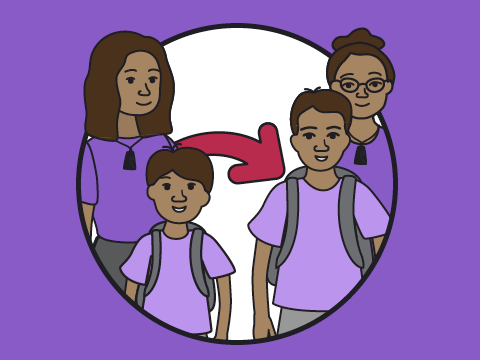Inclusive practice: Primary to secondary | Kura tuatahi ki te kura tuarua
This is another big step for any ākonga. Their day will become longer, and the social and cognitive demands will be different from primary school.
On this page:
On this page:
Current page section: Inclusive practice: Primary to secondary | Kura tuatahi ki te kura tuarua
Go to top of current page: Inclusive practice: Primary to secondary | Kura tuatahi ki te kura tuarua
Go to top of current page: Inclusive practice: Primary to secondary | Kura tuatahi ki te kura tuarua
Go to top of current page: Inclusive practice: Primary to secondary | Kura tuatahi ki te kura tuarua
"Ka pū te ruha ka hao te rangatahi"
When the old net is cast aside, the new net goes fishing.
Why this matters | Te take
Why this matters | Te take
Well-managed secondary school programmes provide a solid platform for moving into valued roles within society. Integrate whānau and ākonga visions of what success means by developing these roles during their secondary years.

Source: Ministry of Education | Te Tāhuhu o te Mātauranga
Sensory supports | Ngā taituarā tairongo
Sensory supports | Ngā taituarā tairongo
Consider aspects such as:
- lighting
- noise levels around the school
- crowded hallways and bag bay areas
- quiet spaces or ‘chill zones’ that can be accessed at any stage in the day
- extreme heat or cold
- stimulation needs, such as movement breaks during the day
- managing stress levels when moving from class to class and the impact of fluid peer groups during the day
- co-constructed work plans
- flexibility within each class environment
- the amount of time it may take to transition between classes
- stress if there is late arrival.
Visual timetables | He wātaka ataata
Visual timetables | He wātaka ataata
As students get older and move around the school, they may benefit from digital-based apps and software that support managing timetables and routines. These can be added to assistive technology devices. Consider apps such as:
Some learners may require an exemption to carry their mobile phones in class. (See: Using phones at school | Ministry of Education).
Plan and assess collaboratively | Te whakamahere me te aromatawai
Plan and assess collaboratively | Te whakamahere me te aromatawai
Consider the following:
- Invite cultural knowledge and identity into all planning. Include whānau from the beginning.
- Coordinate planning with other kaiako in each subject area and consider: routines; workload; moving around the school; break times; special interests when planning learning programmes; workplace transition programmes; assessment timetables.
- Collaborate on assessment methods that meet the needs of ākonga across all subject areas. NCEA level unit standards can be accessed and achieved by developing programmes that build on ākonga strengths. There are internal standards and external standards that may require specific modification of conditions for the learner.
Peer groups | Rōpū aropā
Peer groups | Rōpū aropā
A high school student describes how a peer provides practical support when transitioning between classes in secondary school.
Source: Ministry of Education | Te Tāhuhu o te Mātauranga
Closed Captions
Personal care | Akuaku whaiaro
Personal care | Akuaku whaiaro
Students may require extra support with personal hygiene during their secondary years.
Personal hygiene routines need to consider ākonga dignity, mana and independence.
Consider these aspects:
- menstrual hygiene and assistance
- visual supports for keeping clean and toileting in their new setting
- change areas for places like swimming pools
- social stories for learning about hygiene
- how you notify the student about toilet breaks.
Next steps
More suggestions for implementing the strategy “Prepare your environment | Te whakarite wāhi ako”:
-
Create an accessible learning environment | Te waihanga wāhi ako tomopai
-
Inclusive practice: Early years to primary | Te whare kōhungahunga ki te kura
-
Current page Inclusive practice: Primary to secondary | Kura tuatahi ki te kura tuarua
Return to the guide “Te Ara Ako – Learning pathways in times of change”
How to use this site
Guide to Index of the guide: Te Ara Ako – Learning pathways in times of change
Understand:
Strategies for action:
-
Nurture whānau partnerships | WhanaungatangaShow suggestions for Nurture whānau partnerships | Whanaungatanga
-
Develop ākonga partnerships | Te mahi tahi me ngā ākongaShow suggestions for Develop ākonga partnerships | Te mahi tahi me ngā ākonga
-
Prepare your environment | Te whakarite wāhi akoShow suggestions for Prepare your environment | Te whakarite wāhi ako
- Create an accessible learning environment | Te waihanga wāhi ako tomopai
- Inclusive practice: Early years to primary | Te whare kōhungahunga ki te kura
- Inclusive practice: Primary to secondary | Kura tuatahi ki te kura tuarua
-
Working as a team | He whānau kotahi tātouShow suggestions for Working as a team | He whānau kotahi tātou

